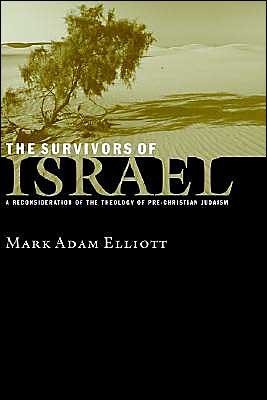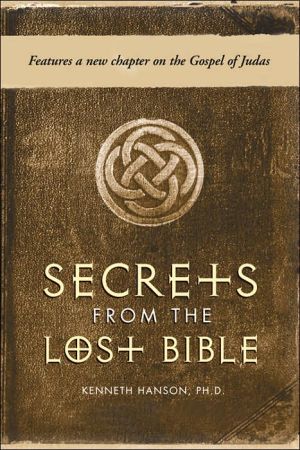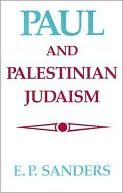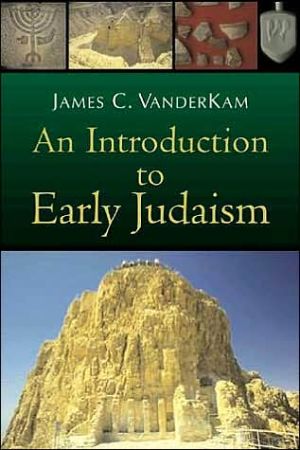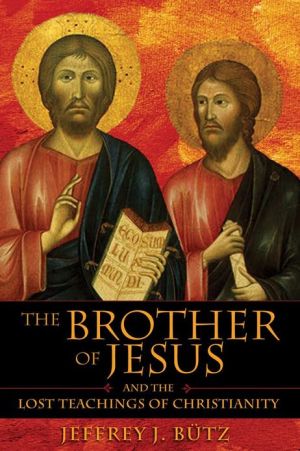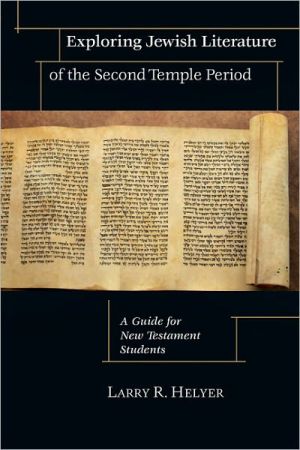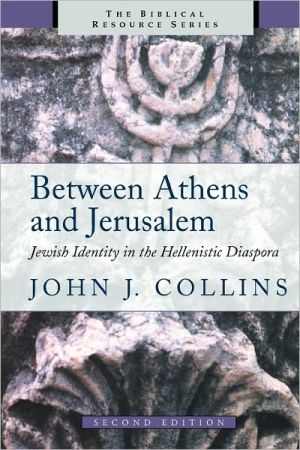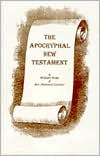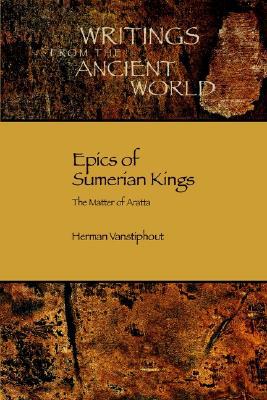The Survivors of Israel: A Reconsideration of the Theology of Pre-Christian Judaism
This study challenges the conventional view of scholars like E. P. Sanders that Late Second Temple Judaism was theologically nationalistic, offering in its place a theory which argues that the intertestamental writings do not anticipate the salvation of all Jews but only of a faithful remnant within Israel. Working carefully with the major books of the pseudepigrapha and the Dead Sea Scrolls, Mark Adam Elliott shows that the authors of such works anticipated an imminent -- and scathing --...
Search in google:
This study challenges the conventional view of scholars like E. P. Sanders that Late Second Temple Judaism was theologically nationalistic, offering in its place a theory which argues that the intertestamental writings do not anticipate the salvation of all Jews but only of a faithful remnant within Israel. Working carefully with the major books of the pseudepigrapha and the Dead Sea Scrolls, Mark Adam Elliott shows that the authors of such works anticipated an imminent -- and scathing -- judgment of Israel that would exclude many, or even most, Israelites from the saved community. This provocative finding not only confronts accepted perspectives on Late Second Temple Judaism but also suggests important implications for our reading of Paul and the New Testament.
SOME NECESSARY REMARKS ON METHOD AND APPROACH (from Chapter 1, pages 2-13)\ \ "Judaism" is far too broad a topic for any single book, so certain limitations have been placed on this book's focus, approach, and purpose. Experience would suggest that such limits, however necessary for the sake of space, can cause certain misunderstandings or methodological difficulties in the study of Judaism—limitation can be judged as deficiency. In order to avoid such misunderstandings and to further explicate the concerns of this book, more will be said about each of these areas of limitation.\ Focus\ Only a select portion of the field of study has been chosen for discussion, even if, as is sometimes necessary, other aspects are discussed along the way, and even if, as is always necessary, the entire field of study is constantly kept in view. This book is interested in Judaism as a critical element—arguably the most critical element—in the study of the origins of the New Testament. With this purpose in mind (which will be discussed more fully below) I have deliberately focused on one group of writings—namely, the so-called Pseudepigrapha, including (or, should we say, along with) the Dead Sea Scrolls, as well as that particular "movement" within Second Temple Judaism that these writings represent. It is unfortunate that the word "Pseudepigrapha" frequently evokes notions of a very enigmatic kind of Judaism, much unlike the rather more straightforward "rabbinic" Judaism, which is represented by the Mishnah and Talmuds (although, when it comes right down to it, a verdict of "straightforward" would be rather difficult to defend for this latter group of writings as well!). The Pseudepigrapha contain visions and strange teachings and revelations, many of which are written in some kind of cipher or code. A full and logical theology of these writings has been judged unattainable—their interest seems to be more on mystical experience than on sober and consistent instruction. The term "apocalyptic writings," which has commonly been used in reference to these books, has for many become synonymous with eclectic dreaming and descriptions of heavenly trivia (to repeat: much unlike the rabbinic writings as popularly conceived). The Dead Sea Scrolls, in practical terms at least, have received a more sympathetic reception, but this is somewhat of a double standard inasmuch as the Pseudepigrapha are also found among the scrolls, and the scrolls have much in common with these other eclectic writings.\ So why choose this literature? Why, in other words, if clarifying the message of the New Testament is so important, has such a concealing and enigmatic literature been chosen to attain this end? Historically speaking, scholarship has seemed to concur with the problem thus stated. For it is certainly true that, even given the recent resurgence of interest in the Pseudepigrapha, studies of the background of the New Testament that focus on rabbinic Judaism still outnumber those that focus on the Pseudepigrapha by a large factor. But to be discouraged from the latter choice by the apparent mysteriousness of the literature is actually quite tragic and completely unnecessary. In fact, as this book will show, there are many positive reasons for choosing these writings. It may even seem a bit surprising, to one accustomed to conventional treatments of the subject, just how consistent, practical, and historically relevant are the topics dealt with in these books. It will also become evident (though it is not the specific concern of this volume) that the concerns of the literature are of critical importance to the illumination of the message of the New Testament.\ Beyond these important practical reasons for reexamining the Pseudepigrapha and the scrolls there is also a more technical aspect, namely, the argument from chronology. It has for some time been suspected that the rabbinic literature, while very important for Judaism historically, has a relatively late provenance and context when compared to this other Jewish literature, perhaps in many respects too late—and thus too historically and ideologically distant—for satisfactory comparison with the New Testament. The Mishnah only began to be "codified" (systematically arranged and recorded) around the beginning of the third century of the Christian era, and much talmudic teaching received its final form only in the following centuries (as late as the ninth century). It is thus in marked contrast to the Pseudepigrapha and the Dead Sea Scrolls, which can all be dated to what is rightly called the formative period of Christianity, the "late Second Temple period"—approximately 200 B.C. to A.D. 100. If these writings are not contemporary with the New Testament per se, they are at least chronologically antecedent, unlike the rabbinic writings.\ The question of chronology also serves as a reminder that the rabbinic literature (in spite of the modern perception created by the dominance of rabbinic views in treatments of Jewish and Christian history) was not formed in a vacuum and, further, did not necessarily represent universally accepted beliefs in Judaism at any time in history. It may be that the deposits of tradition in the Mishnah and Talmud formed the view of the majority, or of "official" circles, at some time or another. This is, however, obviously far from saying that it necessarily helps us to arrive at a suitable background by which to explain or evaluate the theology of the New Testament. The Talmud was the product, so we are coming to realize, of a particular—however popular—viewpoint in Judaism. It is evident that, by the time the rabbinic traditions were codified, historical events (notably the destruction of Jerusalem in A.D. 70) had already exercised a profound effect on the shape of rabbinic teaching, effectively distinguishing it from the Judaism that went before. To this should be added the fact that the Talmud also exhibits a distinct tone of reactionism toward other religious expressions including, significantly enough, the very type of Judaism that this book focuses on, as well as Jewish Christianity, which in many respects is similar to this Judaism. The point is that a literature that reacts against the milieu in which the New Testament arose can hardly provide a balanced, let alone sympathetic, portrait of the Judaism with which the New Testament had so many features in common. The rabbinic literature is not the timeless and universal summary of Jewish belief that it was once taken to be, and it does not adequately reflect the time period in which the New Testament arose. Hence the quite deliberate and, we think, entirely justified focus of the present book on the Pseudepigrapha and the Dead Sea Scrolls.\ Approach\ This book seeks to establish what might be termed a "systematic theology" of the Judaism represented by the Pseudepigrapha and the scrolls.\ According to recent methodological orthodoxy (as well as experience and common sense), any systematic treatment of such a vast and diverse literature is in serious danger of misrepresenting it by forcing it into too neat compartments, of thus overlooking the particular concerns of each separate writing in its individuality, and of carelessly tossing all the documents into a common theological pool, treating them as if they had a single author and were written at the same time. It is accordingly widely considered preferable these days to study one writing at a time, independently of others. In fact, reaction against systematic treatments of Judaism seems to have reached a climax, so that it is even beginning to sound a little platitudinous to point out (as is so often done) that the highly subjective systematizing approach employed in the earliest years of study of the Pseudepigrapha was inspired by little more than a curious interest in these writings as "splendid examples of Jewish apocalyptic," valued only for the light they might cast on parallel phenomena in the Bible. And it can hardly be denied that in initial attempts to treat these writings there was little of what could be called sympathetic study of the books for their own sake. The literature was disrespectfully strip-mined for the benefit of other interests, while little notice was taken of the independent beauty and value of the stones or the variety of color running through the layers of rock. As can be expected from such a degrading approach, lack of concern for the independent integrity of these writings ultimately led to stereotypical and often careless systematization and to a monolithic view of "apocalyptic" origins and doctrine. Critical studies on the separate books were not wanting in the earlier stages of scholarship, but these efforts were overshadowed by the often subconscious presuppositions placed like an umbrella over the whole field of study. So ingrained were ideas about apocalyptic theology in the early days that when criticisms of the approach finally arrived (notably Koch's famous and pioneering Ratlos vor ["Perplexed About"] der Apokalyptik in 1970), even they betrayed a reluctance characteristic of attacks on long-nurtured sacred tradition, and initially their criticisms failed to generate a widespread repentance. It is a remarkable fact that even recent scholars most sensitive to the issues reveal (to an eye accustomed to look for the telltale signs) a subtle respect for, and even a quiet assimilation to, the orthodoxy of traditional apocalyptic scholarship.\ But it is also true that, despite the rather cautious reaction by such initial reevaluations as Koch's, more recent treatments are at least characterized by a much more valid and individualizing approach than their predecessors. More concern than ever before is now being shown for the contingent nature of each work in its particular context, more care in allowing each work to announce its own emphases and concerns, more willingness to recognize a fundamental diversification of origins and viewpoints even within one document. Most important, much less attention is being paid to the quite artificial list of doctrines (such as eschatology or messianology) on the basis of which, in the past, these works were characterized and evaluated. The overbearing concern for theological context is slowly but surely being replaced by an interest in the individual messages of the writings. One can only welcome such advances in methodology and, given that they have been so desperately slow and painful in coming, deem quite unforgivable any return to the superficial systematizing approaches of earlier decades. The critique undertaken by Koch must continue, for in some ways it has been anything but thorough enough!\ But—and this amounts to a significant qualification—more recent individualizing approaches have other serious shortcomings, suggesting that the pendulum has swung a little too far the other way. To put it succinctly, these approaches have proven to be ineffective in unraveling the twisted suppositions provided by earlier systematizing approaches and have also been of limited value in solving the religio-historical question for which this literature still possesses significant import—namely: What is the overall significance of these writings for the history of Judaism and Christianity? Such contingencies seem to demand that the next stage in scholarship adopt a methodology that allows us once again to step back somewhat, in order to take a look at the larger picture.\ This book attempts that step back—with an important difference from earlier systematic approaches, in that it everywhere acknowledges the real benefits of the more synchronic approaches that have arisen lately, without which any attempt to go forward would be quite misdirected. The type of critical analysis that has characterized Pseudepigrapha scholarship is accordingly everywhere assumed by the present treatment and is frequently alluded to in the footnotes where lack of space in the text precludes doing it full justice there. So it needs to be stated unequivocally that it is a matter of bringing one approach to bear on another, not of giving up on valid recent advances.\ But it will still be widely agreed that addressing the above-mentioned religio-historical concern is hardly itself a sufficient justification for adopting a systematic approach, especially since it was those same concerns (and just such an approach) that in the past seriously distorted the investigation of the literature. So what is it about this approach that will help in an understanding of the Pseudepigrapha and Qumran for their own sake? As we see it, there are historical, sociological, and literary justifications for the approach, and a few words can be said about each. There are good reasons for this approach, first of all, from the point of view of history or, at least, the history of ideas. It is in the nature of the case probable that there were vital contacts among these writings and among their authors of the sort that would allow the investigation of one writing to naturally throw considerable light on the understanding of another. While the monolithic view of "apocalyptic" is hopefully now gone forever, this should not be taken to mean that Jewish writers of the period lacked all interaction, that there was not a certain interplay and borrowing of ideas, or that there was not a basic and reasonably intact system of belief shared by these authors. One should still be open to discovering these important connections, especially when they also help to illuminate the documents in their individuality. This is especially important to acknowledge and emphasize now, when it is becoming clear from the multiplicity of detailed studies that there is a distinct danger of "losing sight of the forest for the trees." The present study, in contrast to this trend, also serves to demonstrate how substantive shortcomings in the individualizing studies can be adequately compensated for or even overcome by the investigation of the larger context of the writings (a fresh look at the whole "forest").\ Another justification for this approach comes from recent advances in the sociological study of Judaism. Unfortunately the application of the science of sociological analysis to the fields of biblical and theological research has not always been carried out sagaciously or sensitively, with the result that in some quarters (especially in those possessing special interest in the material under investigation) sociological inquiry is treated with suspicion and general disrespect (no one appreciates being told that there are sociological forces—apparently beyond their control—that explain their actions and opinions). While much of the sociological type of inquiry undertaken in this book will prove to critique and even contradict sociological approaches advanced so far (see ch. 5), it is nevertheless important to acknowledge that the influences of social factors in the Second Temple period have been more or less proven to possess real (only some would say predominating) significance for the formation and explication of Jewish theology. These social perspectives—and this is our point in the present context—have tended to focus attention on relationships and contexts in such a way as to grant prominence once again to the "larger picture." This is largely due to the fact that attention to social factors has encouraged an investigation of the connections among writings, among their authors, and among the societies to which the authors belonged. This is in contrast to individualizing analyses that, no doubt largely due to self-imposed limitations on the scope of such studies themselves, have been unable to incorporate much of this important evidence. This is tragic, inasmuch as certain insights from this science possess undeniable relevance to the subject. Partly in reaction to this lack, vitally important assumptions about social continuity—fundamental to which is the existence of social movements in Second Temple Judaism—have merited a not insignificant role in the present treatment. While sociological study has not always been unqualifiedly helpful for understanding Judaism or Christianity, in other words, this does not mean that a careful and proper sociological methodology (which is cognizant of its limitations as well as its real potential) cannot also help undo the mistakes of the past.\ This kind of inquiry is not limited to understanding the social contingencies of the groups or communities that form a part of a larger movement. There is also a very practical advantage relating to the treatment of the texts themselves that comes from treating them as a kind of social collectivity, inasmuch as—according to the social theorists at least—a kind of social continuity manifests itself in various ways at the textual level. A linguist aware of such factors would put it this way: because texts are socially related in continuous and discontinuous ways, a continuum is established among related texts and the ideas and expressions they contain. A group of texts closely related by underlying social connections has been called a "community of texts." This terminology should not be taken to mean that texts form hard-and-fast canons, as a great deal of fluidity in the boundaries of such social relationships is a natural result of overlap and discontinuity, but it nevertheless properly emphasizes the vitally important need to recognize a social interrelatedness without which the proper study of these writings has been severely impeded in the past. It will become obvious as we proceed how this study has taken advantage of social theory applied to the relationship of texts.\ There are more than a few other implications for a sociological approach stemming from the inherent social aspects of language and literature. One very important implication is on the formal plane—something very important for the study of "apocalyptic" literature, inasmuch as forms (such as revelations, journeys, blessings and woes, judgment oracles, etc.) are exactly what most people think of when they think of "the apocalyptic literature." It seems undeniable that there belongs to all literary forms that arise in a given social milieu something that is commonly called their literary function or, more specifically, their socioliterary function. By "socioliterary function" is meant that texts not only say something, they also do something. Not only do religious authors in tend to express theological teachings or propositions by writing, in other words, but consistently (if unconsciously) there would appear to be some purpose for their writing in the first place, and this purpose forms an essential part of the communication. Much more can be learned about a writer from determination of this purpose than from attention to the surface meaning of the text alone. Attention to the function of a text is an entirely appropriate, and highly practical, method for discovering information about the writer and the writing.\ Sociologists of religion differ on the precise functions to be attributed to any given form, but it is widely agreed (and is common sense) that certain functions come into play in religious settings more than others: these include functions that can be said to be directed inwardly to the community itself—a writing (or part of a writing) might encourage, validate, warn, console, define, identify, or even excite; and they include other functions directed outside the community—they might define or identify (either the community or those outside), validate (the writer's community), argue, justify, explain, appeal, reconcile, discomfort, warn, revile, condemn, or even infuriate. It can be seen from these lists and is also widely agreed that one of the most important driving forces in the existence of religious communities is their claim to legitimacy, which, in turn, lends such typical functions to the literature of a group as "validation," "definition," "identification," "confirmation," "consolation," and "vindication"—terms that will be further defined as we proceed and that we will use often. An important rule of thumb is that similar forms tend to possess similar functions in similar social contexts: "Each genre ... arises in and is appropriate for use in a particular situation." It should also be noted that opposing societies might (consciously or otherwise) break with convention and employ similar forms differently to attain their specific goals; and forms can even become "dead" through repeated use until the original purpose and function is largely lost. Accordingly, the function of each text must be determined by a closer examination of the social context of the individual writing, and although determining this can sometimes become a complex matter, it is a task that is neglected at great cost.\ While it is sometimes tragically overlooked in form analyses today, the earliest form critics realized the social contingency involved in their discipline. Again it hardly needs to be pointed out how important this is for the literature at hand since one of the most widely recognized characteristics of these writings is the employment of certain typical and shared "apocalyptic" forms. But this observation does not only apply to the conventional and easily recognizable forms such as journeys of the cosmos or judgment oracles; less "literary" presentations also lend themselves to formal comparison and social analysis. For example, seemingly straightforward presentations of doctrine—eschatology, pneumatology, messianology—are particularly important examples of catechetical treatises evidencing social functions not easily determinable apart from the larger social context. Thus texts are only rarely intended simply to provide information. Since knowing about the beliefs of a group includes their attitudes toward others and toward themselves (social attitudes), it is therefore logical that one pay attention not only to what the text says, but also to what the author hoped to accomplish by saying it and why the author used a particular form to get the message across.\ What applies so obviously to forms applies also to individual words. It is widely acknowledged that language and terminology (lexicography) are to a degree predetermined by the common linguistic, semantic, and lexicographic presuppositions of the society. Obviously, the more socially isolated a group, the more specialized will their terminology become, and the more the members of that group will depend on their distinct terminology. Given the highly symbolical language of the works to be studied here, certain words appear to function (in the sociolinguistic sense) as evocative "symbols" whose meanings are to an extreme degree socially contingent. More will be said about these in stances as they arise. The point to be made here is that it is only by grouping writings of a similar social milieu that one can adequately determine the social context and solve the various questions of literary function—and thus arrive at the all-important levels of meaning intended by the author. Here then is another justification for treating these writings together.\ One final justification for this kind of systematic approach—perhaps better referred to as a resignation to trends rather than a justification with any independent rationale—relates to the recent surge of attempts by both Jewish and Christian scholars to redefine Judaism from a holistic perspective. This tendency takes the form of a reaction to past generalizations about the subject and by necessity steps back somewhat from detailed analysis to define the major facets common to all of Judaism. One naturally thinks primarily, but not exclusively, of the work of E. P. Sanders, who, in contrast to the more prevailing trend of the day, works systematically in order to discover what he calls "essences" in Jewish literature and eventually the "essence" of Judaism generaliter. While Sanders has been accused of casting his net too widely and assuming uniformity among various kinds of Judaism too fundamentally different to be grouped together, his approach nevertheless demonstrates methodological presuppositions similar to those adopted here, including the idea that a basic structure of thought is likely to be widely held among Jews of similar inclination. The final phrase in that summary—"among Jews of similar inclination" —however, will receive more emphasis in this treatment than we feel Sanders gave to it. That is why we would prefer to apply this kind of generalizing historicism, which is good as far as it goes, to a single chronologically and ideologically circumscribed movement in Judaism rather than to the entire Jewish world over lengthy periods of time. (It is just such a chronological and ideological insensitivity in Sanders's approach that is being recognized as its most serious flaw.) Having stated this qualification, we repeat that the approach taken in this work does not arise in a vacuum as if it were the first to take a "step back," but it is to a point influenced and invoked by the recent scholarly context.\ Purpose\ Finally, the subject matter of this book is limited considerably by its purpose. This purpose is to offer vital prolegomena to the study of New Testament origins. There has been much opposition in the recent past to the idea that one can combine the study of Judaism with interests in Christianity. This is not a totally unjustified concern; indeed, it is a valid reaction to former infelicities in comparative methodology. In the past "interdisciplinary" interests have often led to what can only be called a careless confusion of two religions—specifically, the invalid and quite subconscious practice of viewing Judaism through Christian eyes to the extent that the proper understanding of both is obscured. Judaism, it is implied, is better left to be studied by people of Jewish origin since it is evident (to some at least) that a Christian (or any scholar for that matter who has inherited the faith of the New Testament through tradition or society) possesses prejudices that cannot be shed in order to attain a truly unclouded view of Judaism. This critical observation has accordingly resulted in the charge that New Testament scholars have tended to select evidence that is conducive to their own conclusions.\ But a few observations must be stated by way of response to this point of view. First of all, as has already been indicated, Judaism is a broad subject that cannot easily be handled without limiting the field of study somewhat. Second, no one would deny that some understanding of Judaism is helpful, if not essential, to understanding the New Testament. Third (and as a corollary of the first two), scholars of the New Testament must make some choices about what, exactly, out of the vast world of Judaism, will be the focus of their attention. In other words, the student of the New Testament must start somewhere. As far as this book is concerned—and only its conclusions can justify the choice of this kind of Judaism as a background of the New Testament—that "somewhere" is a movement within late Second Temple Judaism associated with the major Pseudepigrapha from that period and with the Dead Sea Scrolls. If this seems to other scholars of Judaism to be too selective, then one must appeal that the limitations of a single monograph of reasonable size like this one simply demand that a choice be made.\ Furthermore there is no need to assume, simply because students of the New Testament have certain specific concerns in mind, that they cannot also read Judaism accurately. It is not in fact unreasonable to assert the opposite as a possibility, especially since the scholarly world is now beginning to recognize and acknowledge that the New Testament itself belongs centrally (not peripherally) to the literary world of Second Temple Judaism. Nor is there reason to deny the possibility that students of the New Testament might have mastered the context of the specific Judaism, or aspects of Judaism, enough to offer a reasonably valid historical treatment of it. In other words, the selection of particular data from Judaism does not necessarily imply a disregard for all other kinds of Judaism or the ignorance of the fuller and all-important context of Judaism. This book, in fact, is offered as a kind of demonstration that there can be a valid and sensitive treatment of Judaism from the point of view of those who seek its relevance for New Testament study. Thus it contains at one and the same time prolegomena for New Testament study and a valid study of one kind of Judaism in its own right. It asks questions that can be asked of any kind of Judaism—questions about judgment, election, and covenant—as well as questions that are of interest to both Judaism and Christianity—questions about messianology, eschatology, and soteriology. The important point in this is that even these latter topics were of concern to Judaism as well as to Christians, and it is this that has been subtly denied of late (as if such "Christian"-sounding doctrines emerged only after the church had separated from Judaism!). No one would deny that a historical methodology demands that the two religions not be confused—but the conclusions and implications drawn from the assumption (namely, a necessary theological separation of the two faiths in certain areas) are, as a generalization, totally unwarranted. This book has thus been motivated by certain interests related to understanding the New Testament. But one interested only in the Jewish world can read it, because it is a book about Judaism in its own right.
AcknowledgmentsxAbbreviationsxi1.Why Another Book on Judaism?1Some Necessary Remarks on Method and Approach2A Word about Sources and Critical Presuppositions132.Conventional Nationalistic Views of Election in Judaism27The Prevalence and Persistence of Nationalistic Theology in Treatments of Judaism33Latent Tensions in the Conventional View of National Election40The Present State of the Question523.The Judgment-of-Israel Theme57At Qumran58The Widespread Currency of the Theme in Other Intertestamental Writings73Apostasy in Israel1084.Limits on the Community of Salvation115Exclusivist Soteriology in the Dead Sea Scrolls115Exclusivist Soteriology in the Pseudepigrapha118Divine Mercy toward Israel?1785.Reform and Dissent--The Sociohistorical Context187How Does One Account for the Exclusivist Attitude toward Israel?202The Origins and Identity of a Movement2356.Dualistic Covenantal Theology245Dynamic and Dualistic Views of Covenant249Dynamic View of Covenant250Dualistic Covenantal Formulations2737.Soteriological Dualism309Seed Theology314Plant Metaphors329Some Important Implications of Soteriological Dualism3448.A New Approach to Apocalyptic Forms355Historical Rehearsals--Legacy of Israel's Past Performance356Testaments--Final Words of Revered Patriarchs3829.The Dualistic Trajectory of Pneumatology393Jubilees--Israel Abandoned to Evil Spirits396The Dead Sea Scrolls--Dualistic Pneumatology Defines the Metaphysical Universe400Testaments of the Twelve Patriarchs--Choosing between God and Beliar419The All-Important Flood Paradigm42410.The Messiah-for-the-Elect433Approach and Presuppositions434The Messianic Context: Progenitors, Paradigms, and Mystical and Revelatory Figures437The Messiah-for-the-Elect46911.Eschatology in a Dualistic Context515The Dialectic of Restoration in the Zoomorphic History521Judgment and Vindication in the Book of Watchers527A Conditional Restoration in the Apocalypse of Weeks and the "Epistle" of Enoch (Book 5)528Restoration as Conversion in Jubilees533Instruments of Restoration: The Community of the Dead Sea Scrolls540Requisites for Israel's Future Salvation in the Testaments of the Twelve Patriarchs552Seeking Israel's Promised Restoration in the Psalms of Solomon555Eschatological Urgency in 4 Ezra561Warning and Consolation in the Eschatology of 2 Baruch56912."Destruction-Preservation Soteriology"575Paradigms for Salvation576Destruction-Preservation (D-P) Soteriology595The Ultimate Goal--Vindication of the Remnant by the Rest of Israel634Conclusion: Implications of the Theology of the Movement of Dissent for New Testament Study639Theological639Social640Formal641Comparative641A Pause for Misgivings663General Bibliography665Index of Subjects707Index of Modern Authors716Index of Biblical and Extrabiblical Texts728
